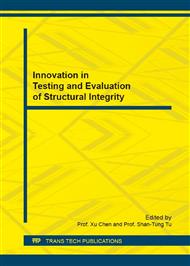p.62
p.67
p.72
p.77
p.83
p.88
p.92
p.96
p.101
The Effects of Nonproportional Loading on the Elastic-Plastic Crack-Tip Fields
Abstract:
In this paper, the loading path effects on the plane strain elastic-plastic crack-tip stress field are investigated computationally. Three different loading sequences include one proportional loading and two non-proportional loading paths are applied to the modified boundary layer (MBL) model under small-scale yielding conditions. For the same external displacement field applied at the outer boundary of the MBL model, the mode I K field and T-stress field combined as the different loading paths are applied to investigate the influence of the nonproportional loading. The results show that for either the compressive or tensional T-stress, the loading path which applied K field followed by T field generates the lower crack-tip constraint. There is only slightly difference between the proportional loading path and that with the T-stress field following by K field. The results show that it is very important to include the load sequence effects in fracture analysis when dealing with nonproportional loading conditions.
Info:
Periodical:
Pages:
83-87
Citation:
Online since:
September 2016
Authors:
Price:
Сopyright:
© 2017 Trans Tech Publications Ltd. All Rights Reserved
Share:
Citation:


